

Imperial Guardian Lion - Chinese Customs. An Imperial Guardian Lion is supposed to have mystic protective powers and can be found in front of such places as temples, imperial palaces, government offices or traditionally in front of homes of high ranking members of society indicating their financial and/ or social status.
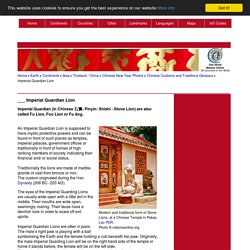
Traditionally the lions are made of marble, granite or cast from bronze or iron. The custom originated during the Han Dynasty (206 BC- 220 AD). The eyes of the Imperial Guarding Lions are usually wide open with a little dot in the middle. Their mouths are wide open, seemingly roaring. Their faces have a devilish look in order to scare off evil spirits. Shishi and Komainu. What´s the difference? Recently I was asked, "What´s the different between Shishi and Komainu?
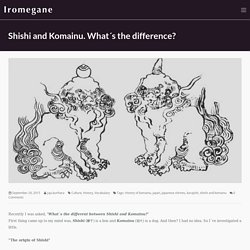
" First thing came up to my mind was, Shishi (獅子) is a lion and Komainu (狛犬) is a dog. And then? I had no idea. So I´ve investigated a little. Do the Easter Island Heads Really Have Bodies? An email containing photos of a startling excavation project has inundated inboxes in recent weeks.

According to the email, the mysterious Easter Island statues — hundreds of huge, ancient carved stone heads that guard the hilly Pacific island landscape — actually have bodies. The email says archaeologists are now unearthing the statues' bodies, which were gradually buried by 500-plus years of erosion. But are the surprising images, and the excavation project they depict, actually real? Are the famous Easter Island heads really full-bodied figures? [Image Gallery: Walking Easter Island Statues] Chariot. Chariot. Chariot, open, two- or four-wheeled vehicle of antiquity, probably first used in royal funeral processions and later employed in warfare, racing, and hunting.
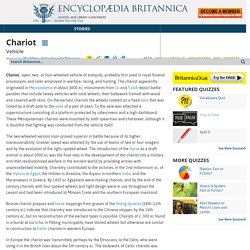
The chariot apparently originated in Mesopotamia in about 3000 bc; monuments from Ur and Tutub depict battle parades that include heavy vehicles with solid wheels, their bodywork framed with wood and covered with skins. On the earliest chariots the wheels rotated on a fixed axle that was linked by a draft pole to the yoke of a pair of oxen. Tapestry. Emperor Qin's Terra Cotta Army. Workers digging a well outside the city of Xi'an, China, in 1974 struck upon one of the greatest archaeological discoveries in the world: a life-size clay soldier poised for battle. he diggers notified Chinese authorities, who dispatched government archaeologists to the site.
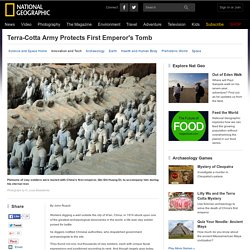
8 Things You May Not Know About Money - History Lists. Nearly 700 years before Sweden issued the first European banknotes in 1661, China released the first generally circulating currency.
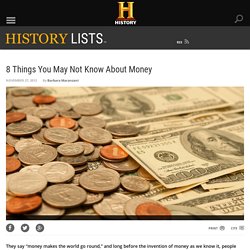
In fact, usage of paper notes dates backs even earlier, to the 7th century Tang Dynasty. For centuries copper coins had been China’s primary currency. Cowboys - Facts & Summary. Predecessors of the cowboy date back to colonial times.

In western Massachusetts, in the uplands of the Carolinas, in Florida, and across the northern, red clay hills of Georgia and Alabama, cattle-raising societies existed long before the Great Plains had been cleared of buffalo. It was in Florida that much of the protocol involving branding evolved. Yet the cattle industry of the Southeast never attracted national attention. The herders never became heroes. Lost Skills of Old West Stagecoach Travel. Credit: Erwin Sherman Tough travel.
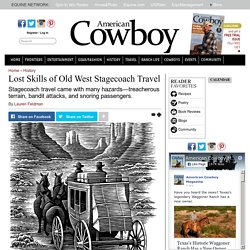
Stagecoaches of the American West. The most profitable contracts to be had by the stage lines were U.S.

Mail contracts, which were hotly contested for. Extinct mammal. Click anywhere inside the article to add text or insert superscripts, subscripts, and special characters.

You can also highlight a section and use the tools in this bar to modify existing content: We welcome suggested improvements to any of our articles. You can make it easier for us to review and, hopefully, publish your contribution by keeping a few points in mind: Encyclopaedia Britannica articles are written in a neutral, objective tone for a general audience. You may find it helpful to search within the site to see how similar or related subjects are covered. Any text you add should be original, not copied from other sources. Clay tablet. Historic writing. The earliest form of writing The earliest writing we know of dates back to around 3,000 BC and was probably invented by the Sumerians, living in major cities with centralised economies in what is now southern Iraq. Temple officials needed to keep records of the grain, sheep and cattle entering or leaving their stores and farms and it became impossible to rely on memory.
So, an alternative method was required and the very earliest texts were pictures of the items scribes needed to record (known as pictographs). These texts were drawn on damp clay tablets using a pointed tool. It seems the scribes realised it was quicker and easier to produce representations of such things as animals, rather than naturalistic impressions of them. A wedge-shaped instrument (usually a cut reed) was used to press the signs into soft clay.
Cuneiform From these beginnings, cuneiform signs were put together and developed to represent sounds, so they could be used to record spoken language. Trebuchet. Facts and interesting information about Medieval Weapons, Armor and arms,specifically, the Trebuchet Definition of a TrebuchetThe Trebuchet was a weapon used during siege warfare. The Medieval Trebuchet was similar to a catapult, or stave sling, which was used for hurling heavy stones to smash castle or city walls. The word 'Medieval Trebuchet' is derived from the Old French word 'Trebucher' meaning to throw over. Arms and Men: The Trebuchet. In June 1210, Count Simon de Montfort besieged two hundred knights, priests, and citizens within the fortress of Minerve as part of his campaign throughout southwestern France to eradicate the Cathar heresy. Considered impregnable, Minerve stood atop a daunting limestone cliff 246 yards above the Cesse River in the region known as the Languedoc.
De Montfort knew that with ample provisions and an internal water source, Minerve’s defenders could outlast any siege, and he had no patience. Within days his engineers had built a towering siege engine: an oversized balance beam with a weighted bucket at one end called a trebuchet — a relatively new arrival on the European battlefield. Sevens Wonders of the Ancient World - Ancient History. Located in what is now southeastern Turkey, the Mausoleum at Halicarnassus was a tomb built by Artemisia for her husband, Mausolus, the king of Carnia in Asia Minor, after his death in 353 B.C. Mausolus was also Artemisia’s brother, and, according to legend, she was so grief-stricken at his passing that she mixed his ashes with water and drank them in addition to ordering the mausoleum’s construction.
The massive mausoleum was made entirely of white marble and is thought to have been about 135 feet high. Egyptian Pyramids - Ancient History. The Taj Mahal - Facts & Summary. Easter Island - Facts & Summary. National Geographic. Site: Rapa Nui National Park (Easter Island) Location: Chile. Capuchin monkey. Click anywhere inside the article to add text or insert superscripts, subscripts, and special characters. Catapult: The Long-Reaching History of a Prominent Medieval Siege Engine. Slavery in America - Black History. United States - The Civil War. Canal, Central America. Physical features. Ancient state [27 BC-476 AD] Theodore Roosevelt - U.S. Presidents. As the 1908 election approached, Roosevelt prepared grudgingly to fulfill the campaign pledge he had made in 1904 not to seek another term, and threw his support behind Secretary of War William Howard Taft.
Neanderthals: Facts About Our Extinct Human Relatives. Egyptian king. Geronimo - Warrior, Military Leader. Italian philosopher, astronomer and mathematician. Galileo - Astronomer, Scientist. Attila the Hun - Military Leader, King. King of the Huns. Lewis and Clark - Facts & Summary. Sacagawea - Native American History. Sacagawea Biography. Mountain man Jedediah Smith is born - Jan 06, 1798. Hadfield, Octavius.